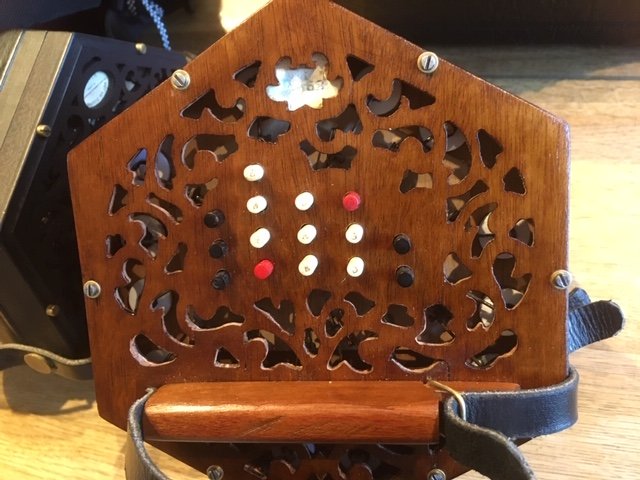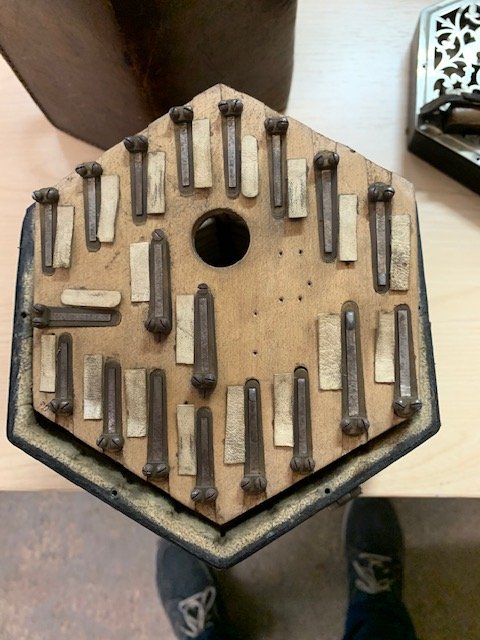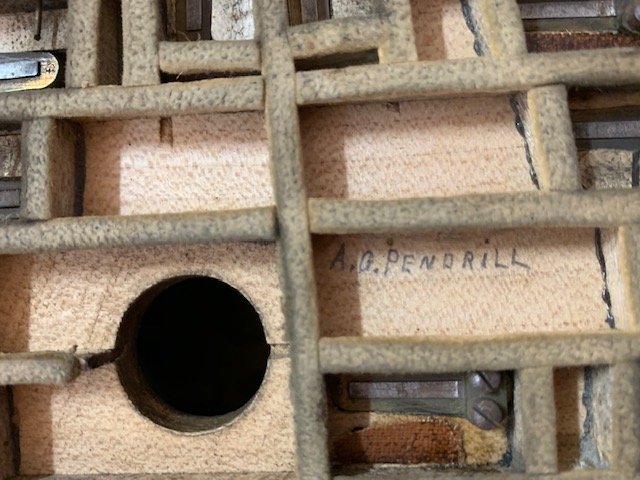
Sprunghub
Members-
Posts
200 -
Joined
-
Last visited
Everything posted by Sprunghub
-
My D# is flat (English Concertina)
Sprunghub replied to Gail_Smith's topic in Instrument Construction & Repair
I would suggest 'yes'......armed with the "Tonal Energy" Tuning App on a mobile phone, something to shim beneath the reed with to support the tip and a good quality nail buffing 'kit' / tool, if no diamond/fine file is to hand. For one pair of reeds and a minor tweak, if your hands are strong enough to clamp the end (to the bellows) and your thighs to hold the instrument for an 'up down' pull push on the one button you will not need to keep screwing it down which, I find is a bit of a pain. No doubt others will cringe at my recklessness !!? -
klingenthal Need a concertina historian.
Sprunghub replied to Brian's topic in Instrument Construction & Repair
Having just done a Presswood re-furb ( as a rank amateur ) and having previously used an encaustic tool with extruded reed wax, I can recommend a hybrid of the CGM paintbrush method with a very economical wax melter from Ebay if a camping stove isn't to hand. The wax pot maintained (via a built in thermostat ) a 'pre-smoke' heat for optimum flow with no nasty fuming. https://www.ebay.co.uk/itm/Hot-Warmer-Handle-Pot-500ml-Wax-Waxing-Heater-Hair-Removal-Depilatory-Paraffin/372636944435?ssPageName=STRK%3AMEBIDX%3AIT&_trksid=p2057872.m2749.l2649 -
That is a very pretty tuning rig, but a fairly ugly application. Ebay sells 'shim steel' you can get small sheets for no money which will create a very thin support for the reed which will slide almost down to the fixing point. With the shim beneath it will elevate the reed tongue slightly, even for the belly/low filing. It also allows you to 'fine' file the side of the reed at the filed point which may have some displaced steel from the abrading which can snag the aperture. Filing the belly, to lower pitch - even supported - allows (causes ?) the tongue to drop at the tip so I found an almost invariable need to tweak the tip out and reformat the curve to bring the up. The other thing to weigh up is that if it is 5 - 10 high "in" the instrument......it will potentially be a different 'score' outside, ie. on the tuning jig, so there is an ongoing calculus for each reed of the difference "inside" and outside the 'Tina. My finishing is done with the reed back in the 'box' with the end clamped under hand pressure, other end between the thigh's ie. without bolts in place just to assess the one note. Personally I found the note 'deflection' inside and outside, to be pretty standard which meant that I could apply a standard differential. There are posts from people who know on how those differentials apply.
-
Excellent supplier of Chamois.....if you tell them it is for concertina work they seem to know what to select from their range. https://www.russels.com/
-
I managed to replicate the 'finish' on my 1923 Lachenal using a generic French polish.....but.....when stripped (entirely down to bare wood ) it became apparent that the original FP included a pigment/stain. As I only needed to re-finish one end the difference is obvious. Personally, I think the FP'd "natural" mahogany is very attractive but it is not original, or matched on mine. I used late 1800's Mahogany for the infill work which is a perfect match ( from a re-claimed, machined down Parquet tile ) If required - FP plus appropriate pigment (or pre-pigmented FP ) would appear to be 'a' way to go. Images are in current listing as below. (Ignore the matt black Anglo image)
-
As a relative beginner - on Duet rather than Anglo, but similar principals applying - I too use the foam insulation and 'slacker' straps. Finger length/joint's length makes a difference. As someone who could not play a barre chord if my life depended on it ( on the guitar ) because of hand geometry, I find I need to be stood 'off' the rest to get any articulation at the joints. The trouble is, once I find I am too far off, I lose control of where my hands are on the slack straps, especially for those 'fly-away' notes on the 1st/5th row. I also find that, if not using the foam, a pair of Altura 'classic' cycle gloves works well !! The loose(r) strap grips to the crocheted back and the suede padding on the palm holds to the handle when needed. They also keep the hands warm for playing when the hands/fingers are cold!
-
The left end of a 64 button Wheatstone Aeola with leather case
Sprunghub replied to Rikki's topic in Buy & Sell
35174, 25th April (built) / 1st May (shipped?) 1939, 64 keys....from the ledgers. It was a busy week for 'buttons' as the preceding instrument had 81 and the next two 56. All denoted 'E' for Ebony/ised, but nothing to indicate style. Presumably the 81 wasn't an English! -
Agreed, entirely.....but if you use a selling medium, you presumably do so with a reasonable understanding of the fee's, and to expect more return, it questions what the expected selling price/reserve would have been? Clearly higher than that achieved. The buyer would have been spending over £4k, irrespective of what the vendor would accrue after their costs. It still feels a high price to pay ( if not to receive ! ) especially as it didn't sell.
-
The left end of a 64 button Wheatstone Aeola with leather case
Sprunghub replied to Rikki's topic in Buy & Sell
I very nearly put a bid on the listing for the sake of the case....I am sort of glad I didn't as it would have been too big! A nice one though irrespective of the end(s) it included and very good value. I did wonder how many 'clicked' through the photo's past those of the box! -
Would that - after buyers premium and VAT on the premium - not have been a reasonable price to attain ? Particularly as it is ( is it not ?? ) after all a later Wheatstone, albeit with Jeffries 'pattern' Duet fingering, so not a Jeffries per se, with it's added kudos. Re the Linota, which looked very tidy, a 'silent' and seized Linota basket-case with mismatched parts (metal and bone buttons at least) sold for nearly £4k after costs at a North Wales auction the other day. I attended a local 'country auction' this morning re. a 30k Rosewood Lachenal, basic Lachenal staple mechanism, in entirely 'silent', somewhat rusty and latterly 'desiccated' condition, no one else in the room seemed very interested but 'lively bidding' on the phone and Net took it to £620 after costs before it stalled, which seemed very expensive for a 'project'. Are expectations exaggerated ? ....and if they are, are the created by on-line/distance/blind bidding on occasion.
-
Anglo E/F key: annoying click
Sprunghub replied to Carola's topic in Instrument Construction & Repair
Hainsworth "Doeskin", 100% Merino Wool material as used in Guards tunics is a traditional option, I think. Being inexpert, I sourced some of the piano material and real wool baize, but found it too thick to 'roll' into a cord to thread the buttons onto, or, to work properly once on the lever. I have found the Doeskin just right for all bushing options. -
Edward Jay's 3D-printed EC!
Sprunghub replied to Wolf Molkentin's topic in Instrument Construction & Repair
Eddy came to the recent Beginners weekend run by WCCP and demo'd the printers in action- making a bellows - the component parts and the instrument being played via a lunchtime performance in the hands of a lady 'EC' player. I think (know!!) a few respected Board members were present, so someone may comment as to tone/playability. As I understand it the bellows on the Demo model which was played were 'proper'/traditional bellows and the reeds are accordion type of top quality. The lever to pads are as per comments above 'ball and cup', so fully articulated. He is a very personable chap and I am sure he would welcome contact via his various on-line options. He's an ace accordion player too. Duo's with Will Pound on the Folk circuit. -
Neck strap for playing standing ?
-
A timely question Dave.....I am a non-music/dot reader who has to annotate the notes atop the stave and try to read keep up as I play normally. I am - as previously expressed, very taken with your posts. I am, the more I annotate, learning to read the dots, but it's not coming naturally or very fast when playing through. I try to learn from the annotated notes then play by ear/memory. I sat last evening and worked my way through your Xmas Tune book via the tunes I knew/recognised which was most of them. Reading it from the page via the Lap top, I ended up either having to stop and page down or play by ear the parts that were 'off the bottom of the page' ( I know I could have printed it but the Boss say's the ink is low! ) The animated page as per this post eliminates that need. I know a growing number of 'Session night' players who use a Notebook to act as an aide memoir whilst singing and / or playing and I think the rolling presentation is a useful aide for us latecomers. I guess my only 'add' to a wish list would be for a 'suggested chord' pattern above the music.....in a contrast colour......but that may be too much of an ask. I know enough to work through and work them out now.....but not in my head. Personally the landscape is preferred....
-
Alfred Pendrill Snr & Jnr Bn1851 & Bn1873
Sprunghub replied to Sprunghub's topic in Concertina History
Many thanks Geoff. I thought that the most likely explanation. It's a shame he didn't date the work as so many do. -
Jeffries 39 Button Anglo Keyboard Variations
Sprunghub replied to adrian brown's topic in Instrument Construction & Repair
Hi Alex. To my inexperienced eye they look un-fettled. If any work has been done it would appear to be very negligible. Over the years there have been some valves replaced and some very crude work done on bushing etc, probably in the 1940's/50/60's judging by materials used, ie carvings of lino and electrical insulation ! none of which belong in a concertina, but it doesn't look as if the reeds have been touched to any degree. As per your first, having now sat with Adrian's notation, it transposes fairly well from the C/G buttons across most notes. -
Jeffries 39 Button Anglo Keyboard Variations
Sprunghub replied to adrian brown's topic in Instrument Construction & Repair
Hi Alex - tuning was assessed using an App (TE Tuner) reg'd at 444hz, when pretty much all the buttons showed as being "in" tune, +/- a few cents, across the board? At 460hz it does indicate Ab/Eb, but 40+ cents out? The reeds are marked as A/E rather than Ab/Eb etc? whereas the D#'s etc - where appropriate - are marked as such, as opposed to Eb, when corresponding to the tuner....if that means anything. -
Jeffries 39 Button Anglo Keyboard Variations
Sprunghub replied to adrian brown's topic in Instrument Construction & Repair
I am resurrecting this thread in the light of a recently acquired instrument that has long been out of circulation. It appears to be un-standard to the enth degree, even by the standard of there not being a "standard" ! But, it is what it is, so we will come to terms with it. I am not sure if the attachment will be good enough to read. A/E tuning ? at 444hz currently. The reed stamps indicate it is tuned as it was made. Notation.docx -
I have had the good fortune to come across a Jeffries bearing an internal mark for A. G. Pendrill. It would appear there were a father and son, Alfred senior, at 20 yrs was a cabinet maker, at 40, 50 and 60 years he was a "Concertina worker" in London according to basic census data. He may well have survived until 1930. Alfred Jnr was a Concertina Tuners apprentice aged 18 ( Bn 1873 ) and a tuner at 28, but may have left the trade by early middle age to become a Tobacco and Confectionary retailer. Indications are he may have survived as late as 1966, which would be a good age for both if correct. It may be just a mark made during a 'service' rather than construction, but I wondered if the name was familiar to anyone re. Jeffries workers. It is the only internal mark apart from '38' marked on (inside) bellows and action board, with 'L' & 'R' for the appropriate ends.
-
I have sent you a PM. regards, N
- 16 replies
-
- duetconcertina
- duet
-
(and 1 more)
Tagged with:
-
Lazy closure on 'A' note/button
Sprunghub replied to Sprunghub's topic in Instrument Construction & Repair
Thanks again for the above.....I seem to have fixed the problem. The back story to the instrument is that it had a 'lot' of work, major work in some respects, realigning of levers, replaced posts etc done some time ago by a 'top' Uk restorer and although I stripped my little 35b box down to parts and rebuilt ends and re-tuned it from scratch (with assistance/advice from the Forum) this thing makes my hands sweat/shake every time I have to take a screwdriver (actually a Feeler Gauge!) to it. As it happened, I had over-ordered on the pads for my 35b by a couple so I had one spare from Mark L-A sat in the cupboard. For the smaller instrument it was a mm or so larger than those used on the 55b, 15mm as against 14mm ? but, as the other 29 pads on that end are 1mm or so smaller, there was adequate room for the 'one' larger one. It appeared that the pad was marginally 'off-centred', so I have replaced it with the slightly larger one and re-centred it and whilst not being too adventurous until the glue goes off, it now, pending a proper test, appears to be resolved. I have re-pressed the bush as advised too and left a bit of graphite on there so fingers are crossed and will no doubt be again once I start trying to find my notes. -
Tune & Easy Notes The Green Fields Of France-TAKE TWO
Sprunghub replied to voyager's topic in Teaching and Learning
Cheers Dave....I come to this song from singing it unaccompanied ( the Men They Couldn't Hang version ) which is a simplified ( according to my ear ? ) tune to EB's original and your playing. I then learnt to chord accompany 'strummed' on guitar and then fingerpick the chords. I am new to the Concertina, wanting to sing and play Duet, preferably at the same time! so it is useful to find tunes/songs I recognise/understand as I don't need to be trying (too hard) to remember the words/tune as well as making fingers move in the right place/order. I have downloaded the 'free' intro version of Notation Composer and can see how that works via their pre-loaded examples....I have also downloaded Audacity and managed to convert a WAV file from my laptop into an MP4. 'My' laptop runs on 'old' Windows which they seem to suit. I have a Tascam which records WAV files. It's not recognising that as a readable file by Notation yet.... so it may not be a MIDI. It will probably not like it anyway because it is a recording on the Duet of melody with chords behind/over as opposed to single notes. Either way I will persevere.






